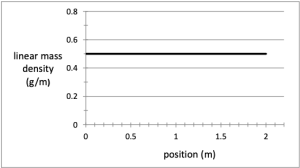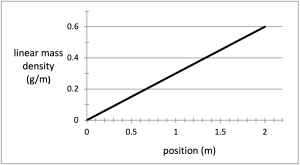Type A Theory Exercise 1: Density
Type A Evaluation: Theory
Exercise 1: Density
The plate, shown below, has a mass of 320 g.

What is its density? (Use units of g and cm.)
The density that you are most familiar with is the volume mass density (i.e. the mass per unit volume), but, there are other kinds of densities…
Excess charge on a metal always resides on the surface. Suppose that 160 nC of charge are uniformly distributed over the top surface of the plate shown. In this case, it makes more sense to calculate density in terms of area rather than volume.

What is the surface charge density? (Use unit of nC and cm.)
Even when calculating a mass density, the geometry may favour a lower dimensionality. For example, a string is usually long compared to its diameter and so even though you could calculate a mass per unit volume for the string, it might be more convenient to use a linear mass density (i.e mass per unit length).
![]()
A 10 m long wire has a mass of 2 g. What is its linear mass density? (Use units of g and m.)
You will come across many kinds of densities in physics — particle density, charge density, current density, energy density, etc. You will want to get used to thinking more broadly about the definition.
Given the mass and dimensions of a uniform object, you can calculate its density (in whatever form). Now consider the reverse operation…
The graph below shows the linear mass density as a function of position (i.e. the mass density function) along a uniform piece of wire which is 2 m long.

What is the mass of the wire?
What if the wire has a linear mass density which is NOT uniform? For example, in the graph below you can see that the mass density of the wire increases along its length.

What is the mass of the wire?
